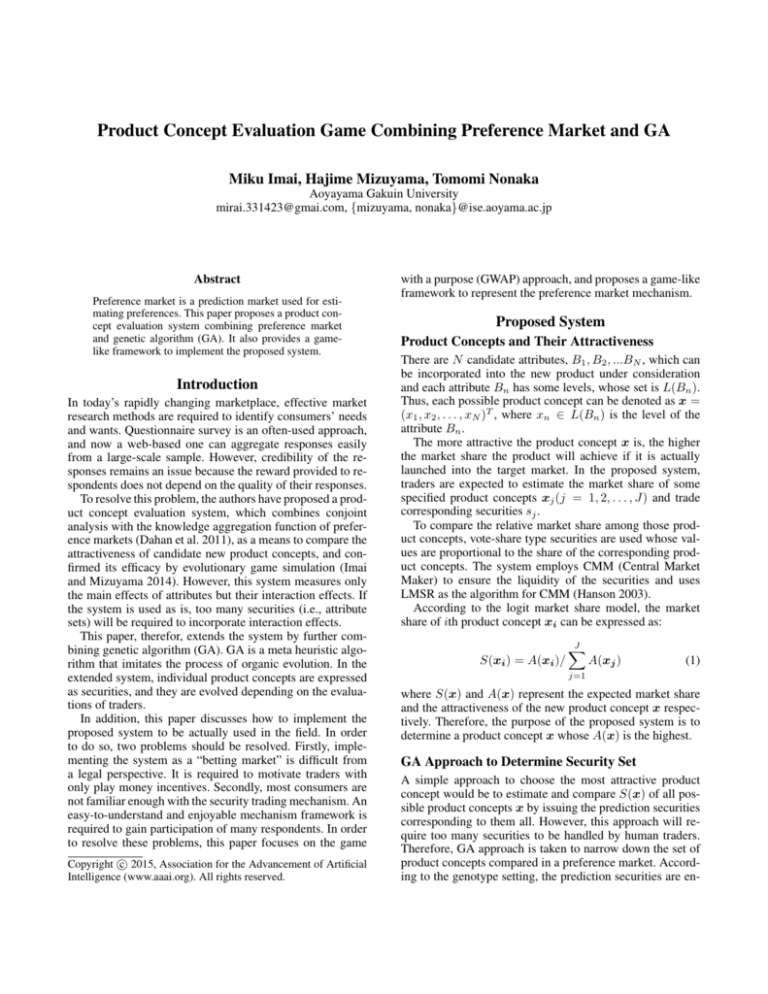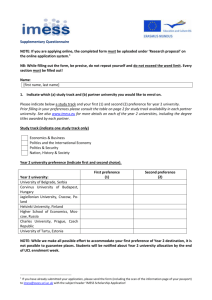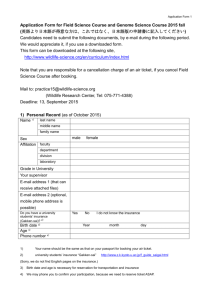
Product Concept Evaluation Game Combining Preference Market and GA
Miku Imai, Hajime Mizuyama, Tomomi Nonaka
Aoyayama Gakuin University
mirai.331423@gmai.com, {mizuyama, nonaka}@ise.aoyama.ac.jp
Abstract
Preference market is a prediction market used for estimating preferences. This paper proposes a product concept evaluation system combining preference market
and genetic algorithm (GA). It also provides a gamelike framework to implement the proposed system.
Introduction
In today’s rapidly changing marketplace, effective market
research methods are required to identify consumers’ needs
and wants. Questionnaire survey is an often-used approach,
and now a web-based one can aggregate responses easily
from a large-scale sample. However, credibility of the responses remains an issue because the reward provided to respondents does not depend on the quality of their responses.
To resolve this problem, the authors have proposed a product concept evaluation system, which combines conjoint
analysis with the knowledge aggregation function of preference markets (Dahan et al. 2011), as a means to compare the
attractiveness of candidate new product concepts, and confirmed its efficacy by evolutionary game simulation (Imai
and Mizuyama 2014). However, this system measures only
the main effects of attributes but their interaction effects. If
the system is used as is, too many securities (i.e., attribute
sets) will be required to incorporate interaction effects.
This paper, therefor, extends the system by further combining genetic algorithm (GA). GA is a meta heuristic algorithm that imitates the process of organic evolution. In the
extended system, individual product concepts are expressed
as securities, and they are evolved depending on the evaluations of traders.
In addition, this paper discusses how to implement the
proposed system to be actually used in the field. In order
to do so, two problems should be resolved. Firstly, implementing the system as a “betting market” is difficult from
a legal perspective. It is required to motivate traders with
only play money incentives. Secondly, most consumers are
not familiar enough with the security trading mechanism. An
easy-to-understand and enjoyable mechanism framework is
required to gain participation of many respondents. In order
to resolve these problems, this paper focuses on the game
c 2015, Association for the Advancement of Artificial
Copyright Intelligence (www.aaai.org). All rights reserved.
with a purpose (GWAP) approach, and proposes a game-like
framework to represent the preference market mechanism.
Proposed System
Product Concepts and Their Attractiveness
There are N candidate attributes, B1 , B2 , ...BN , which can
be incorporated into the new product under consideration
and each attribute Bn has some levels, whose set is L(Bn ).
Thus, each possible product concept can be denoted as x =
(x1 , x2 , . . . , xN )T , where xn ∈ L(Bn ) is the level of the
attribute Bn .
The more attractive the product concept x is, the higher
the market share the product will achieve if it is actually
launched into the target market. In the proposed system,
traders are expected to estimate the market share of some
specified product concepts xj (j = 1, 2, . . . , J) and trade
corresponding securities sj .
To compare the relative market share among those product concepts, vote-share type securities are used whose values are proportional to the share of the corresponding product concepts. The system employs CMM (Central Market
Maker) to ensure the liquidity of the securities and uses
LMSR as the algorithm for CMM (Hanson 2003).
According to the logit market share model, the market
share of ith product concept xi can be expressed as:
S(xi ) = A(xi )/
J
X
A(xj )
(1)
j=1
where S(x) and A(x) represent the expected market share
and the attractiveness of the new product concept x respectively. Therefore, the purpose of the proposed system is to
determine a product concept x whose A(x) is the highest.
GA Approach to Determine Security Set
A simple approach to choose the most attractive product
concept would be to estimate and compare S(x) of all possible product concepts x by issuing the prediction securities
corresponding to them all. However, this approach will require too many securities to be handled by human traders.
Therefore, GA approach is taken to narrow down the set of
product concepts compared in a preference market. According to the genotype setting, the prediction securities are en-
GA Approach
Devise
product concepts 𝒙
Apply crossover and mutation
operations to individuals
Determine individual set
brought into preference markets
No
Is the
Yes
individual's attractiveness
the highest?
Individuals are treated as prediction
securities and evaluated in
preference markets
Distributor
Product A
Area 3
Product B
Translate product
concepts into
individuals
through binary coding
Target:
Families
Product C
Player A
Return
Purchase
Locate Stores
Area 1
Estimate attractiveness 𝐴(𝒙)
of each individual from its
market share 𝑆(𝒙)
Preference
markets were run
𝑀 times?
Yes
No
Preference Market Approach
Player A
Target:
Undergraduates
Area 2
Target:
Salaried Workers
Revenue
Choose the concept 𝒙 with the highest
attractiveness 𝐴(𝒙)
End
Customers
Player A’s
Retail Store
Distributor
Other Players’
Retail Stores
Figure 1: Overview of proposed system
Figure 2: Overview of proposed game framework
coded through binary coding and they are evolved depending on the evaluations of traders, as shown in Figure 1.
Payoff Determination
Product concepts compared in the preference markets are in
their hatching stage, and it is difficult to obtain their actual
market share at the time of determining the payoff. Thus, the
payoff should be determined somehow based on the status of
the preference markets themselves. However, it is observed
that this way may deteriorate the prediction accuracy.
Therefore, the following two devices are introduced for
incentivizing traders to behave truthfully. Firstly, the system
uses the smoothed values, such as VWAP (volume weighted
average price), instead of the market closing price for estimating the attractiveness, and thereby reduces the impact of
the transactions just before the closure. Secondly, it runs several preference markets in parallel and determines the payoff
in each market by using the price data obtained from all of
them, and thereby offsets the possible bias in the price data
of a market.
Proposed Game Framework
This section discusses how to implement the proposed system as a predigested game which maintains the system’s
functions. The basic functions include (1) to induce players
to estimate the market shares (i.e., attractiveness) of specified product concepts, (2) to let players trade goods (i.e.,
securities) corresponding to the concepts based on their estimated attractiveness, (3) to fluctuate the goods’ prices according to the transactions, (4) to show players how the
prices fluctuate,and (5) to calculate and provide a payoff for
each good.
In the proposed game, each player manages one or more
retail stores, as shown in Figure 2. There are some areas and
target clientele differs from area to area. Each player can
choose some areas to locate his/her retail stores, but only
one store in one area. Then, the player buys some products
from a distributor and sells them in a season, and the assets at
the end of the season including the benefit are his/her game
score.
The player can purchase products from several different
distributors, and the category of products varies among distributors. Further, the assortment of products in a distributor
changes between seasons. Any products should be bought
in a lot unit, whose size differs from product to product so
that the selling price of a whole lot is equal. Although the
selling price of each product is decided in advance, its cost
prices will vary according to its rating. The products can be
returned to the distributer at any time within a purchase period, and the refund depends on its cost price at the time.
After a purchase period, the products arrive in the retail
store. Then, the products may go out of stock or remain unsold in units depending on their attractiveness.
In this game, each distributor functions as a preference
market, and the products purchased by the players from the
distributer correspond to the prediction securities in the market. Their cost prices represent the security prices and are
calculated based on LMSR. The product set sold in a distributor is determined by GA in every season.
As can be understood from that players purchase products in a lot unit, a product lot corresponds to a piece of
prediction security. Further, the number of leftover products
in each lot adjusts the difference between its selling price
and the payoff of the corresponding prediction security.
Conclusion
This paper developed a product concept evaluation system
by combining GA with the preference market mechanism,
and implemented the system as a game. Experiments are
also conducted with two web applications. One of them implements the proposed system according to the game framework, and the other implements the system as it is. In future work, the concept of idea market will be incorporated
into the system to make it possible to collect new ideas from
consumers.
References
Dahan, E., Kim, A.J., Lo, A.W., Poggio, T. and Chan, N.
2011. Securities Trading of Concepts (STOC). In Journal of
Marketing Research 48:497-517.
Hanson, R. 2003. Combinatorial Information Market Design. In Information Systems Frontiers 5:107-119.
Imai, M. and Mizuyama, H. 2014. Product Concept Evaluation System Applying Preference Market. In HCOMP 2014.










